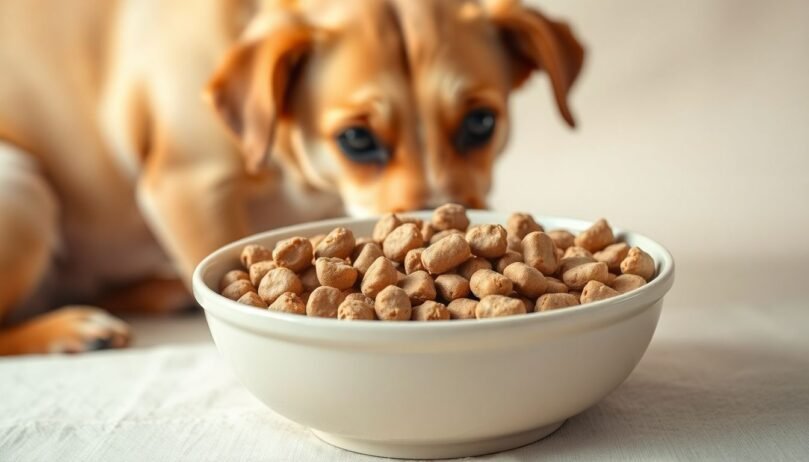What to Feed Dogs With Kidney Disease
- 11 March 2025
- BuyAPet Editorial Team
- All Dogs, Dog Health
What to Feed Dogs With Kidney Disease: A Complete Guide
Imagine your furry pal isn’t their usual self—drinking more, peeing more, and a little off. The vet confirms kidney disease. It’s scary, but the right diet can make a real difference. This guide simplifies kidney-friendly nutrition so you can keep your dog comfortable and thriving.
Understanding Canine Kidney Disease
Your dog’s kidneys filter waste and balance electrolytes. When they struggle, toxins build up—this is kidney disease (renal failure). It may be acute (sudden) or chronic (gradual). Vets often use staging systems (like IRIS) to gauge severity and guide care.
Common Signs
- Increased thirst and urination
- Lethargy, decreased appetite, weight loss
- Vomiting, bad breath, dull coat
Important: Work with your vet for diagnosis and a tailored plan. Diet supports medical care—it doesn’t replace it.
The Role of Diet in Managing Kidney Disease
Nutrition helps reduce the kidneys’ workload, ease symptoms, and support quality of life. Key goals typically include managing protein, phosphorus, and sodium, while improving hydration and adding helpful omega-3s.
Key Nutrients (Overview)
| Nutrient | Why it matters | General approach |
|---|---|---|
| Protein | Excess can increase nitrogenous waste. | Feed controlled amounts from high-quality, digestible sources (e.g., eggs, lean poultry) per vet guidance. |
| Phosphorus | High levels can speed progression. | Choose low-phosphorus diets; avoid foods with phosphate additives. Vets may add binders if needed. |
| Sodium | Can affect blood pressure and kidney load. | Use moderate sodium; avoid salty treats and processed meats. |
| Potassium | May run high or low in CKD. | Monitor via bloodwork; adjust with your vet (diet or supplements). |
| Omega-3 (EPA/DHA) | May help support kidney function and reduce inflammation. | Vet-approved fish oil or renal diets that include omega-3s. |
| Moisture | Hydration supports kidney health. | Prioritise wet food and abundant fresh water; consider broths (low-sodium). |
Best Food Choices for Dogs With Kidney Disease
Commercial Kidney-Friendly Diets
- Look for veterinary/prescription or vet-recommended renal diets formulated with controlled protein, reduced phosphorus, and appropriate sodium.
- Wet (tins/pouches) boost hydration; some dogs prefer pâté textures.
- Transition gradually (see plan below) to avoid tummy upsets and protect acceptance.
Homemade Diets (Only With Vet/Nutritionist Guidance)
- Use a board-certified veterinary nutritionist or your vet to formulate the recipe—balance matters.
- Typical components may include lean meats in controlled portions, low-phosphorus carbs (e.g., rice, some squash), and selected veg (e.g., green beans).
- Avoid random online recipes; imbalances can be harmful.
Foods & Treats to Avoid
- Processed meats, jerky with high salt, cheese, salty snacks
- High-phosphorus items (organ meats, bones, sardines without vet approval)
- Phosphate additives on labels (e.g., “phosphoric acid,” “sodium phosphate,” “dicalcium phosphate”)
- No grapes/raisins, onions/garlic, xylitol, chocolate (toxic to dogs)
Feeding Strategies & Tips
Portion Control & Schedules
- Offer small, frequent meals to reduce GI load and nausea.
- Base portions on your vet’s calorie target for your dog’s weight and disease stage.
- Monitor weight weekly; adjust intake with your vet if weight drifts.
Encouraging Appetite
- Warm food slightly; add a splash of low-sodium broth or water for aroma and moisture.
- Try different textures (pâté vs. chunks); hand-feeding for short periods can help.
- Ask your vet about anti-nausea meds, antacids, or appetite stimulants if needed.
Hydration Wins
- Multiple water bowls; keep them clean and topped up.
- Consider a pet fountain—many dogs drink more from running water.
- Wet food as the main diet; add water to meals if tolerated.
Simple 7-Day Transition Plan
| Day | Old food | Renal diet |
|---|---|---|
| 1–2 | 75% | 25% |
| 3–4 | 50% | 50% |
| 5–6 | 25% | 75% |
| 7+ | 0% | 100% |
Slow down if stools loosen or appetite dips; check with your vet if refusal persists.
Monitoring & Adjusting the Diet
- Regular bloodwork (creatinine, BUN/urea, phosphorus, potassium) and urinalysis per your vet’s schedule.
- Track appetite, energy, weight, thirst/urination, vomiting/nausea.
- Ask your vet about adding omega-3s, phosphate binders, or anti-nausea medications as appropriate.
Conclusion
Diet is a cornerstone of managing canine kidney disease. Partner closely with your vet to choose the right food, support hydration, encourage steady appetite, and adjust as lab results change. With the right plan, many dogs enjoy a comfortable, happy life.
